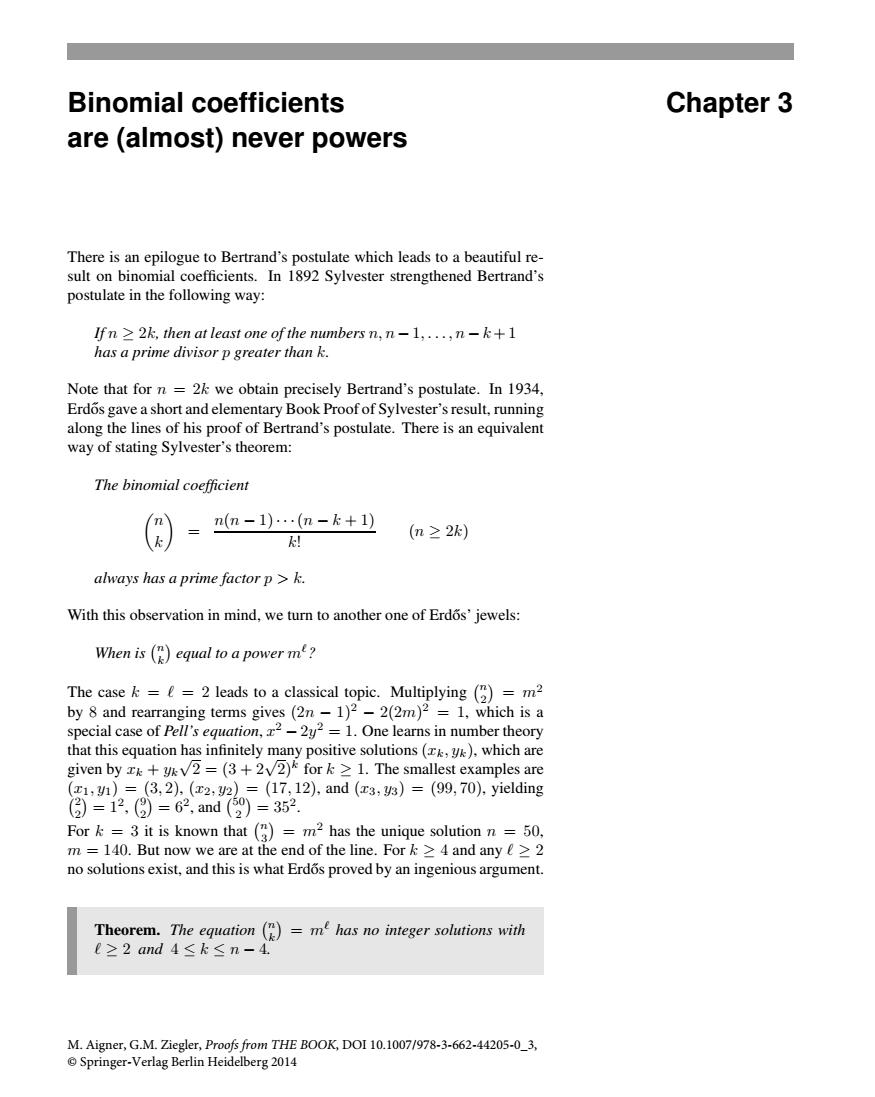正在加载图片...

Binomial coefficients Chapter 3 are (almost)never powers There is an epilogue to Bertrand's postulate which leads to a beautiful re- sult on binomial coefficients.In 1892 Sylvester strengthened Bertrand's postulate in the following way: Ifn >2k,then at least one of the numbers n,n-1,...:n-k+1 has a prime divisor p greater than k. Note that for n =2k we obtain precisely Bertrand's postulate.In 1934, Erdos gave a short and elementary Book Proof of Sylvester's result,running along the lines of his proof of Bertrand's postulate.There is an equivalent way of stating Sylvester's theorem: The binomial coefficient n(m-1)(m-k+1 k (n≥2k) k! always has a prime factor p >k. With this observation in mind,we turn to another one of Erdos'jewels: When is (equal to a power m? The case k=e=2 leads to a classical topic.Multiplying (2)-m2 by 8 and rearranging terms gives(2n-1)2-2(2m)2=1,which is a special case of Pell's equation,x2-2y2=1.One learns in number theory that this equation has infinitely many positive solutions (k,y),which are given by k+kV2=(3+2√②)kfork≥l.The smallest examples are (a1,1)=(3,2),(x2,2=(17,12),and(x3,gg)=(99,70),yielding 伯=12,(份=62,and()=352. For k =3 it is known that (2)=m2 has the unique solution n=50, m 140.But now we are at the end of the line.For 4 and any e>2 no solutions exist,and this is what Erdos proved by an ingenious argument. Theorem.The equation ()=mt has no integer solutions with l≥2amd4≤k≤n-4 M.Aigner,G.M.Ziegler,Proofs from THE BOOK,DOI 10.1007/978-3-662-44205-0_3, Springer-Verlag Berlin Heidelberg 2014Binomial coefficients are (almost) never powers Chapter 3 There is an epilogue to Bertrand’s postulate which leads to a beautiful result on binomial coefficients. In 1892 Sylvester strengthened Bertrand’s postulate in the following way: If n ≥ 2k, then at least one of the numbers n, n − 1,...,n − k + 1 has a prime divisor p greater than k. Note that for n = 2k we obtain precisely Bertrand’s postulate. In 1934, Erdos gave a short and elementary Book Proof of Sylvester’s result, running ˝ along the lines of his proof of Bertrand’s postulate. There is an equivalent way of stating Sylvester’s theorem: The binomial coefficient n k = n(n − 1)···(n − k + 1) k! (n ≥ 2k) always has a prime factor p>k. With this observation in mind, we turn to another one of Erdos’ jewels: ˝ When is n k equal to a power m? The case k = = 2 leads to a classical topic. Multiplying n 2 = m2 by 8 and rearranging terms gives (2n − 1)2 − 2(2m)2 = 1, which is a special case of Pell’s equation, x2 − 2y2 = 1. One learns in number theory that this equation has infinitely many positive solutions (xk, yk), which are given by xk + yk √2 = (3 + 2√ 2)k for k ≥ 1. The smallest examples are (x1, y1) = (3, 2), (x2, y2) = (17, 12), and (x3, y3) = (99, 70), yielding 2 2 = 12, 9 2 = 62, and 50 2 = 352. For k = 3 it is known that n 3 = m2 has the unique solution n = 50, m = 140. But now we are at the end of the line. For k ≥ 4 and any ≥ 2 no solutions exist, and this is what Erdos proved by an ingenious argument. ˝ Theorem. The equation n k = m has no integer solutions with ≥ 2 and 4 ≤ k ≤ n − 4. M. Aigner, G.M. Ziegler, Proofs from THE BOOK, DOI 10.1007/978-3-662-44205-0_3, © Springer-Verlag Berlin Heidelberg 2014